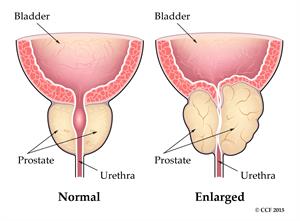Holmium laser enucleation of the prostate (HoLEP) is a treatment for men with benign prostatic hyperplasia (BPH). The laser surgery removes blockages of urine flow. This treatment is done without any incisions on the body.
What is holmium laser enucleation of the prostate (HoLEP)?
Holmium laser enucleation of the prostate (HoLEP) is a type of laser surgery used to treat obstruction (blockage) of urine flow as a result of benign prostatic hyperplasia (BPH). In men with BPH, the prostate gland is not cancerous but has become enlarged. An enlarged prostate can result in a number of urinary tract symptoms such as frequent urination, inability to urinate, difficulty in starting urination, or loss of bladder control.
HoLEP was developed in the 1990s as a more effective and potentially less costly surgery for urinary obstruction due to BPH, as compared to other surgical options such as laser vaporization and transurethral resection of the prostate.
How does holmium laser enucleation of the prostate (HoLEP) work?
The holmium laser is a surgical laser that has been found particularly effective in performing several types of urological surgeries. In the case of HoLEP, the laser is used to cut and remove the bulky prostate tissue that is blocking the flow of urine

The goal of HoLEP surgery is to relieve the symptoms commonly associated with an enlarged prostate, including:
- an urgent or frequent need to urinate,
- difficulty starting to urinate,
- frequent stopping and starting during urination (weak urine stream),
- increased urination at night that disrupts sleep,
- inability to empty the bladder completely, or
- inability to urinate at all (urinary retention).
HoLEP Procedure
On the day of your HoLEP surgery, you will meet with your urologist to discuss the procedure.
If you have any of these symptoms or conditions, discuss them with your doctor prior to the surgery:
- inability to lie back with your legs raised for a prolonged period of time (this is necessary during the procedure),
- bleeding disorders or blood thinner medications,
- pain or difficulty urinating that came on suddenly or recently,
- an urgent need to urinate that has gotten worse over time,
- history of severe bleeding or blood clots, or
- high fever (over 101 degrees).
You will also meet with an anesthesiologist, who will explain the process of anesthesia and answer any questions you have. The anesthesiologist will administer general anesthesia (put you to sleep).
Procedure Length
The entire procedure usually takes about three to four hours, but it may be shorter or longer depending on the size of your prostate.
During the Procedure
After you are under anesthesia in the operating room, your surgeon will look at your prostate through a small camera (cystoscope) inserted into your urethra (the small tube that connects your bladder to your penis) through the tip of your penis. The surgeon will insert a small laser and scope, which are used to cut extra tissues in the prostate causing BPH symptoms. The prostate tissue will be removed leaving only the prostate capsule. The tissue is typically removed in two to three large pieces, which are put into the bladder. Your surgeone will use a laser to seal up any blood vessels. A second device called a morcellator will break up the prostate tissue in the bladder and suction it out. There may be a small amount of tissue left behind that will be safely urinated out of your system.
Before the procedure is finished, your surgeon will insert a catheter to flush out any blood. A catheter is a small tube that runs from the bladder through the urethra and drains urine into a bag outside your body.
